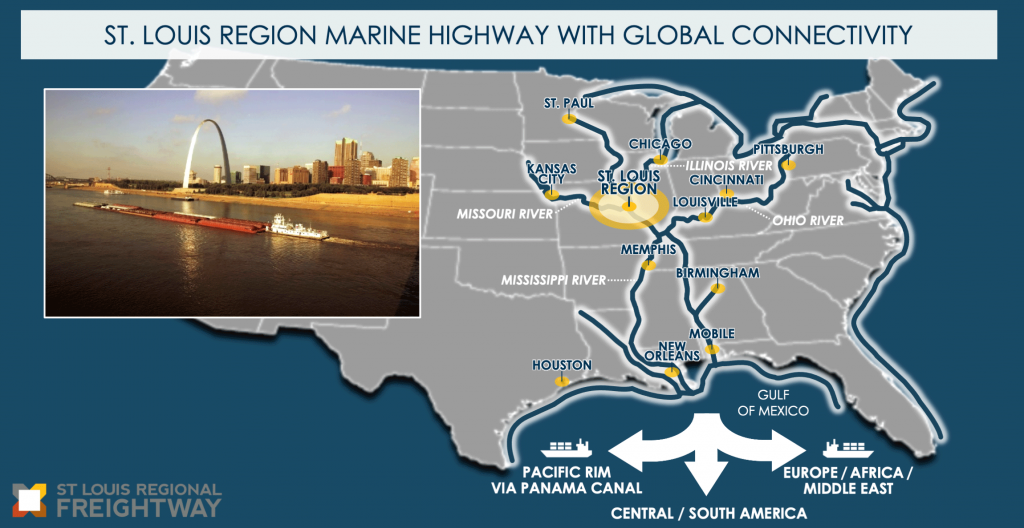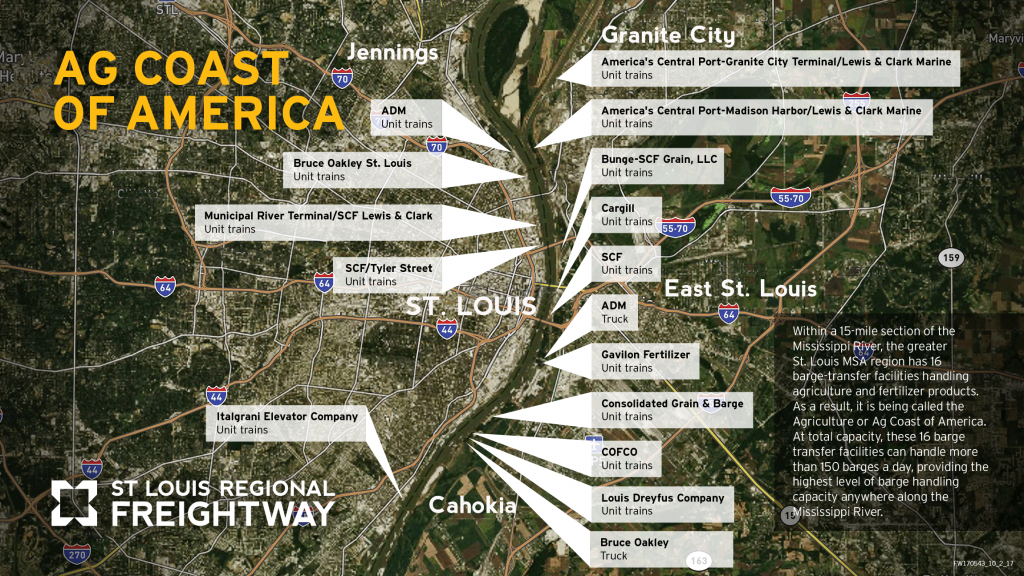Four ports with ample available industrial user real estate
Northernmost lock- and ice-free port on the Mississippi River
105 million tons of cargo through the region annually
Three Ports with Container on Barge Capabilities
The ports and barge industries within the St. Louis Regional Freightway are based centrally along the Mississippi River, within close proximity to America’s agricultural heartland, major Midwest populations and manufacturing centers. The St. Louis region is served by the six North American Class I rail carriers, the regional switching carrier Terminal Railroad Association of St. Louis (TRRA) and other short line rail carriers. The region’s cost-effective rail service and modal flexibility provide national reach, carrier reliability, reduced travel times and competitive transportation costs.
The St. Louis Regional Freightway’s port system includes both the Port of Metropolitan St. Louis and portions of the Port of Kaskaskia, IL. Our strategic location on the Mississippi River is the northernmost lock and ice-free port on the river and offers substantial fleeting operations. Efficiency has emerged as a hallmark of the region’s port system, which not only is one of the country’s largest inland ports, but also the most efficient. The St. Louis region’s port system is responsible for 70 of the 855 miles (8 percent) of the Mississippi River from Minneapolis, Minn., to the Ohio River near Cairo, Ill. These 70 miles carry almost one-third of the river’s total freight, a direct reflection of the system’s efficiencies. The barge industry routinely handles approximately 436,000 tons per mile, which is almost two-and-a-half times more efficient than its closest competitors. This activity takes place at the 200-plus private terminals operating within our region’s port system, each of which can be seen on our interactive map.
Ag Coast of America
These strengths are even more evident along a 15-mile stretch of the Mississippi River which has gained recognition as the Ag Coast of America. It is home to 16 barge-transfer facilities that, at total capacity, can handle more than 150 barges a day – the highest level of capacity anywhere along the Mississippi River. Currently, 50% of U.S. crops and livestock are produced within a 500-mile radius of the St. Louis region, including approximately 80% of corn and soybean acreage. The St. Louis region’s strategic location on the river, infrastructure assets and multimodal connectivity enable it to play a crucial role in moving those commodities.
Ramping up for Container Market Growth
With the new wave of larger ocean carrier container vessels, projected global growth in the container market by 2030, and the emphasis to reduce truck traffic on the nation’s highway system, ports in the bi-state St. Louis area and other Midwest regions are working together to provide container-on-barge (COB) and a proposed container-on-vessel (COV) service. These efforts include ports investing in new equipment, repositioning of empty containers, channel deepening and other infrastructure investment. The goal is to continue to grow the number of containers and start moving product via this COB service launched at America’s Central Port in 2020.
Innovative container-on-vessel (COV) service on the Mississippi River and adjacent inland rivers would pair with COB service as part of a hub and spoke system that would serve key consolidation ports of the St. Louis region, Memphis, Tenn., and several other feeder ports. The Port of Herculaneum in Jefferson County, Missouri, has been identified as a hub for a key terminal in the proposed service. The COV service is part of a plan calling for patented new waterway vessels that will swiftly move large volumes of goods and commodities along the inland waterways, effectively creating an all-water north-south trade lane connecting the Midwest to the lower Mississippi River and on to worldwide destinations. Based on recent milestones reached, including securing an appropriation of $25 million from the state of Missouri in 2022, service on the new route could be available to shippers in 2025, and shippers using the new service could see cost savings ranging from 30 to 40 percent.
The Freightway’s four ports offer an abundance of industrial user real estate for commercial and industrial development.
“The amount of river business in the St. Louis region has disproportionately increased over the past three decades. This region is a rail and interstate highway gateway. It is more cost-effective to move commodities into, out of and through St. Louis by combinations of truck, rail and barge than points upstream on the Mississippi and Illinois Rivers. Barge loading and unloading capacity has expanded in the St. Louis area to take advantage of these train rates and barge freight rate adjustments.”


